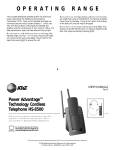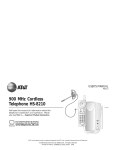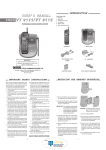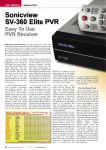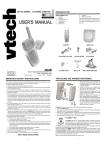Download AT&T 9110 User's Manual
Transcript
© 1998 Philips Consumer Communications L.P. All rights reserved. Printed in China. 848233334 Issue 1AT&T Part 2 Fold open this manual for information about this telephone’s installation and operation. Please read Part 1 — Important Product Information, included in this package. User’s Manual for Cordless Telephone 9110 2 INSTALLATION Puts a caller on hold. Belt Clip— Slide over the back of the handset until it snaps firmly in place. Handset Volume Control MUTE/LOW BATT indicator goes on when battery needs to be charged, or the Mute function has been activated. PHONE indicator goes on while you are on a call. Makes a call. Headset Jack Ends a call. Access Call Waiting or other services. Speed dial your first memory dial number. Temporary Tone Accesses memory dialing numbers. Redials last call made. Programs a number in memory or changes ringer type. Mute 2 INSTALLATION Standard power outlet Power cord Telephone line cord Telephone jack Strain relief hook Power jack 1 Setting up the Cordless Telephone 9110. • Choose an area near an electrical outlet and a telephone jack. • The outlet should not be controlled by a wall switch. 2 Connect the telephone line cord. • Insert one end of the telephone line cord into the jack at the rear of the base unit. Plug the other end into a telephone jack. Make sure the plugs snap securely into place. 3 Connect the power cord. • Plug the AC power adapter into a standard electrical outlet and the DC connector into the power jack located at the rear of the base unit. • Wrap the power cord around the strain relief hook on the bottom of the base unit (see illustration). The strain relief hook helps protect the power cord from accidentally being removed. CAUTION: Use only the AC power adapter supplied with this telephone. This is a Class 2 AC adapter, specifically designed for use with the 9110. NOTE: Connect power to the base unit before placing the handset in the cradle. 4 Set the dial mode switch. If you have touch tone service on your phone line, set the switch located on the bottom of the base to TONE. If you have rotary service, set the switch to PULSE. 5 Install the handset battery. • Remove the handset battery cover by pressing the indentation on the handset battery cover and sliding the cover downward. Telephone jack Slots Base unit Slots Tabs Reversible base Clips Thicker end • Place the handset battery pack in the compartment. Make sure the metal contacts on the underside of the battery are aligned with the charging contacts in the handset battery compartment. • Replace the handset battery cover by sliding it on its track up and over the handset battery compartment until it snaps firmly in place. 6 Charge the handset batteries before use. Place the handset in the base unit cradle either in the face up or face down position. Make sure that the 1 IN USE/CHARGE light on the base is on. The handset battery must be charged a minimum of 6 hours before using your phone for the first time. The batteries recharge automatically whenever the handset is placed in the base unit cradle. 7 Check for dial tone. After the batteries are charged, pick up the handset and press . The PHONE indicator should light up, and you should hear a dial tone. If not, see “IN CASE OF DIFFICULTY" in this manual. INSTALLATION continued CAUTION: 1 Never install telephone wiring during a lightning storm. 2 Never install telephone jacks in wet locations unless the jack is specifically designed for wet locations. 3 Never touch uninsulated telephone wires or terminals unless the telephone line has been disconnected at the network interface. 4 Use caution when installing or modifying telephone lines. Wall Mounting 1 Choose a spot where the telephone wall jack is near an electrical outlet. This phone requires a modular telephone jack and a standard electrical outlet (120V AC). 2 Remove the reversible base. The reversible base is designed for both table and wall mount installations. The telephone comes with the reversible base installed in the table mount position. To wall mount this telephone you will need to remove the reversible base and position it so that the thicker end is toward the front of the telephone (see illustration on previous page). You can remove the reversible base by depressing the clips on each side of the base while gently lifting upwards. 3 Reattach the reversible base. • Insert the tabs of the reversible base into the slots on the bottom of the telephone base. • Gently press the thicker end of the reversible base until it snaps firmly in place. 4 Connect the telephone line cord. • Using the short telephone line cord supplied, insert one end of the telephone line cord into the telephone jack on the rear of the telephone base. • Feed the remaining line cord to the rectangular opening by pressing the line cord into the grooves of the reversible base leaving at least 3 inches free. Plug the line cord into the standard wall jack. 5 Connect the power cord. Plug the power cord into the jack on the back of the base. Plug the AC adapter into an electrical outlet. 6 Mount the telephone to the wall jack. Position the telephone base so the mounting studs on the wall jack fit into the reversible base. Slide the telephone down on the mounting studs until the phone locks in place. TELEPHONE OPERATION Making a Call 1 Press on the handset and wait for the PHONE indicator to go on. 2 When you hear a dial tone, dial the number. NOTE: When another extension is in use on the same line, and the Cordless Telephone 9110 is in standby mode, the PHONE indicator on the handset will flash. The IN USE/CHARGE indicator will not function when the handset is out of range. Answering a Call If the handset is in the base: NOTE: The IN USE/CHARGE indicator will increase intensity with the incoming ring. 1 Lift the handset. 2 The PHONE indicator goes on and the call will be connected. If the handset is away from the base: NOTE: The IN USE/CHARGE indicator will flash with each incoming ring. Press any key on the handset (except , volume control or ). This is very useful in a dark environment; you do not have to fumble around looking for the key to answer the call. 3 Ending a Call If you are near the base: Place the handset in the base. If you are away from the base: Press . Volume Control The Volume Control allows you to increase or decrease the loudness of an incoming voice. Handset Receiver Volume Control (located on the left side of the handset) 1 To increase the sound level, press the key. 2 To decrease the sound level, press the key. TELEPHONE OPERATION continued Special Telephone Services If you subscribe to special local telephone company services like Call Waiting or Call Forwarding, you can access them by pressing whenever you would press the switchhook on a regular phone. IMPORTANT: If you are using the Hold feature to switch to another extension, you must first place the call on Hold. After the extension phone has been picked up, release the Hold feature and press on the 9110 to resume your conversation on the extension phone. Redial To redial the last number dialed from the handset: 1 Press . 2 Wait for the PHONE indicator to go on and for a dial tone. 3 Press . The last number you called is stored in the redial memory until you dial another number. Advanced AutoSelect Feature The Cordless Telephone 9110’s advanced AutoSelect feature will automatically select the clearest channel, even during a conversation. During automatic channel change your conversation may be interrupted for about 1 second while the unit scans and selects a new channel. Mute Mute allows you to hear your caller but prevents the caller from hearing you. 1 Press . 2 The MUTE/LOW BATT indicator will light to indicate the Mute feature is activated. 3 To continue your conversation, press again. Ringer Mute Press on the handset during incoming ringing to disable the ringer for the duration of the call. Hold The Hold feature allows you to keep a call on the line while you step away from the phone or while you or someone else takes the call on an extension phone. 1 Press . 2 The PHONE indicator will blink slowly to indicate the call is on hold. 3 To release Hold, press again. Temporary Tone If you have dial pulse (rotary) service, this feature allows you to enter codes or tones needed to operate answering machines, or use electronic banking services, calling cards, and other special services. This feature will operate most special services; however, some services may actually require a touch tone line. To be sure, ask the company that provides the special service. NOTE: If you have touch tone service, you do not need to use the Temporary Tone feature. To use temporary tone dialing: 1 Dial the call normally. 2 Press . 3 Enter numbers or symbols required. 4 End the call normally (Temporary Tone is automatically shut off). 4 Programming the Ringer Type The handset ringer is capable of four different types of ringing tones. The following sections detail how to change the different tones and to turn off the ringer on the handset. To program, the handset must be . To select a different ringer type do the following: 1 Press . 2 Press . 3 Press a key ( - ) to select a ringer type. 4 Press . Turning Off the Ringer To turn off the ringer on the handset, do the following: 1 Press . 2 Press . 3 Press to turn off the ringer. 4 Press . To turn ringer on again, see “Programming the Ringer Type.” Checking the Ringer To check the ringer which is currently programmed, do the following: 1 Press . 2 Press . 3 Press again to check the ringer. 4 Press . Page/Handset Locator This feature is useful if you misplace the handset. To locate the handset using the Handset Locator feature: 1 Press . 2 A repeating paging tone is sounded at the handset for approximately 30 seconds. To cancel the Handset Locator feature: Press on the handset or press on the base. MEMORY Memory Features This telephone can store 21 telephone numbers, each up to 20 digits long. Numbers will remain stored in memory unless you erase or change them by entering other numbers. Programming a Number into Memory Make sure the handset is . 1 Press . The PHONE indicator will blink to indicate that you are in the programming mode. 2 Enter a number button (00-20). 3 Enter the phone number (up to 20 digits). 4 Press to store the phone number to the key you selected. The phone now exits programming mode and emits a tone. NOTE: If programming is unsuccessful, the unit will generate an error tone. NOTE: You may choose to store emergency numbers in memory locations. The manufacturer assumes no responsibility for customer reliance upon this memory feature. Quick Memory Dialing The key gives you one button access to the speed dial number stored in memory location “00.” This may be a frequently dialed friend, business, or emergency number, such as 911. There are two ways to dial using the key. 1 Press . 2 Press . The phone number stored in memory location “00” will be automatically dialed. — OR — 1 The handset must be . 2 Press . The phone number stored in memory location “00” will be automatically dialed after a 2-second delay. Dialing a Number Stored in Memory 1 Press to get a dial tone. 2 Press . 3 Press the number button (00-20) you assigned to that phone number. For example, to dial the phone number you assigned to button “06,” press , , . IN USE/CHARGE Indicator When the handset is in the base cradle, the IN USE/CHARGE indicator increases intensity with each ring of the incoming call. When the handset is not in the base, the IN USE/CHARGE indicator flashes steadily. After the call is answered, the IN USE/CHARGE indicator will remain lit until the end of the call. Memory Card There is a memory card with an erasable surface located on the telephone base unit to record the names or telephone numbers for the first 10 (locations 01-10) numbers stored in these memory locations. NOTE: The 9110 has a total of 21 memory locations (number locations 00-20). Programming a Pause Into a Memory Dial Phone Number If your phone is connected to a PBX (switchboard) you may have to dial a special number (e.g., 9) to get an outside line. When programming a number into memory, store the access number and a pause into the number sequence. The pause will allow the switchboard enough time to give you an outside line dial tone. To insert a pause in a stored number, press the key. This inserts a 2-second pause after that digit. To insert a longer pause, press the key two or more times. Each time you hear another beep, it makes the pause 2 seconds longer. For example, to store 9, PAUSE, 555-1234: Press , . Then press . NOTE: Each pause you program is counted as a digit. You can program up to 20 digits in each memory location. Changing or Replacing a Stored Number You can change or replace a stored number by storing a new number in its place. Spare Battery Charger (under Memory Card) Memory Card Base Antenna POWER indicator goes on when the base power adapter is plugged into an electrical outlet. IN USE/CHARGE Indicator—see description above SPARE BATTERY indicator goes on when you are charging a spare battery. Page/Handset Locator 5 BATTERIES About the Handset Batteries You will know the batteries need charging when: • The phone beeps two times when you press to answer or make a call. • The MUTE/LOW BATT indicator on the handset flashes. • The phone does not respond when you press and the PHONE indicator does not go on. Charging the Handset Batteries Place the handset in the base so the IN USE/CHARGE indicator goes on. The batteries will be fully charged in 6 hours. Once the batteries are fully charged, you need only put the handset in the base when the MUTE/LOW BATT indicator flashes. If it is more convenient for you to do so, you can leave the handset in the base all the time. It is impossible to overcharge the batteries. If the batteries don’t charge properly: If you get a low-battery signal even after 6 hours of charging, the battery should be replaced. CAUTION: To reduce the risk of fire or injury to persons or damage to the telephone, read and follow these instructions carefully. • Use only Replacement Battery 3470. • Do not dispose of the battery in a fire. The cell might explode. Check with local codes for special disposal instructions. • Do not open or mutilate the battery. Released electrolyte is corrosive and may cause damage to the eyes or skin. It may be toxic if swallowed. • Exercise care in handling batteries in order not to short the battery with conducting materials such as rings, bracelets, and keys. The battery or conductor may overheat and cause harm. • Charge the battery provided with or identified for use with this product only in accordance with the instructions and limitations specified in this manual. • Observe proper polarity orientation between the battery and battery charger. 1 2 3 4 5 Replacing the Battery Pack Remove the battery compartment cover on the handset by pressing on the indentation and sliding the cover downward. Lift out the old battery pack. Place the new battery pack in the compartment. Make sure the metal contacts on the underside of the battery are aligned with the charging contacts in the battery compartment. Replace the cover by sliding it on its track up over the battery compartment until it snaps firmly in place. The new batteries must be charged before using your telephone. Place the handset in the base unit and allow it to charge for 6 hours. The telephone may operate before that but, for best performance, let the batteries charge fully. Power Reserve The Cordless Telephone 9110 has the ability to provide back-up power to the telephone base in the event of a power failure. For this feature to work, it is necessary to have a fully charged spare battery (PURCHASED SEPARATELY) installed in the base unit Spare Battery Charger (located under the directory card on the telephone base unit). If a power failure or interruption occurs, the Cordless Telephone 9110 will automatically 6 switch into the Power Reserve mode. When operating in the Power Reserve mode, the phone’s features and functions should operate normally until the spare battery charge has been depleted. When power is restored to the telephone base unit, the phone will automatically switch back to its normal operating mode. IMPORTANT: The amount of time the Cordless Telephone 9110 will operate during a power failure will vary depending on use and spare battery charge level. Spare Battery Charger The Cordless Telephone 9110 is equipped with a spare battery charger built into the base unit. The spare battery charger allows you to always have a charged battery available, should your handset battery discharge during normal use. To install the Spare Battery Pack (PURCHASED SEPARATELY): 1 Open the base unit battery compartment. 2 Place the spare battery pack in the battery compartment. Make sure the metal contacts on the underside of the battery are aligned with charging contacts in the battery compartment. 3 Replace the battery compartment cover. 4 When the battery is installed properly, the SPARE BATTERY indicator on the base unit will be illuminated. 5 The spare battery will be fully charged after 16 hours. Please note that the SPARE BATTERY indicator will always be illuminated when a spare battery is installed. BATTERIES continued Battery Case Charging Contacts Battery Case Cover Battery Pack Spare Battery Charger Charging Contacts SPARE BATTERY indicator 7 IN CASE OF DIFFICULTY If you have difficulty operating this phone, try the suggestions below. If you still have trouble, call 1 800 722-9125. If the phone does not work at all, check these items first: • Make sure the power cord is plugged into an outlet not controlled by a wall switch. • Make sure the telephone line cord is plugged firmly into the base and the telephone jack. • Make sure the base antenna is upright. • If the phone does not beep when you press , the batteries might need recharging. • If the MUTE/LOW BATT indicator is on, the batteries need recharging. • Make sure the battery pack is installed correctly. • If you have dial pulse service on your telephone line, the Dial Mode Switch must be set to PULSE. If you hear noise or interference when using the phone: The advanced AutoSelect feature of the phone should normally minimize any interference. In some situations, however, you might notice some noise or interference when using the phone. Follow the suggestions below. • Make sure the base antenna is upright. • You may be out of range. Move closer to the base. • Household appliances plugged into the same circuit as the base can sometimes cause interference. Try moving the appliance or the base to another outlet. • The layout of your home or office may be limiting the operating range. Try moving the base to another location—preferably on an upper floor. If the phone does not ring when you receive a call: • Make sure the ringer is turned on. If you are away from the base, make sure the base antenna is upright. • Make sure the telephone line cord is connected firmly to the base and the telephone jack. Make sure the power cord is plugged in. • You may be too far from the base. Move closer to the base. • You may have too many extension phones on your telephone line to allow all of them to ring. Try unplugging some of the other phones. If you hear other calls while using the phone: • Disconnect the base from the telephone jack, and plug in a regular telephone. If you still hear other calls, the problem is probably in your wiring or local service. Call your local phone company. If you hear noise in the handset, and the buttons don’t work: • Make sure the power cord is plugged in, and make sure the base antenna is upright. 8 If you are unable to operate special telephone services or other equipment requiring touch tone signals: • If you have dial pulse (rotary) service, press on the handset before entering information (see “Temporary Tone”). • The tones generated by this phone may not be long enough to activate some services or equipment. You might need to use a different touch tone phone. If you have difficulty entering numbers into Memory: • Review “Programming a Number into Memory” to make sure you are pressing the correct sequence of buttons. • If the number is more than 20 digits long, make sure you follow the instructions for “Programming a Number into Memory.” Make sure you have followed all the instructions in this booklet. If you continue to have problems, call 1 800 722-9125.
















